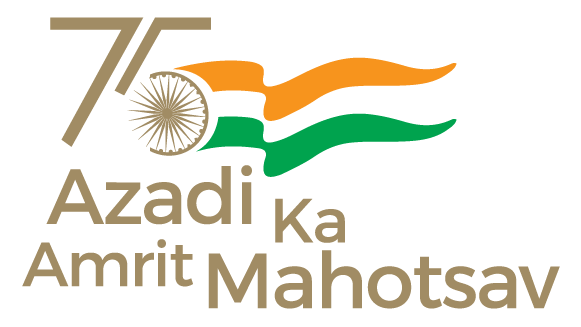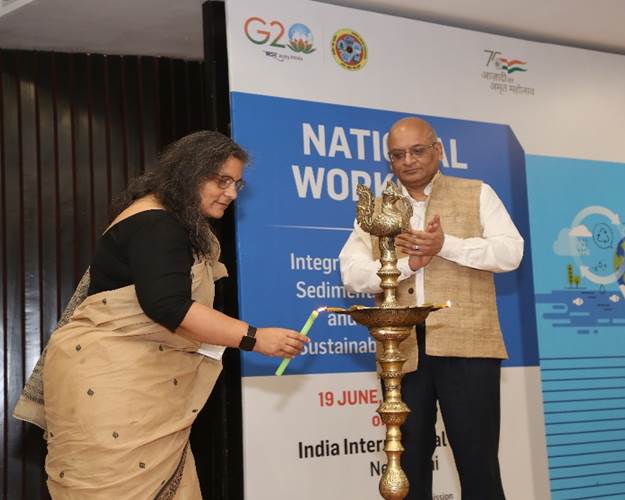
The Central Water Commission under Ministry of Jal Shakti organized a one-day national workshop on ‘Integrated Management of Sediments in River Basins and Reservoirs for Sustainable Development” at India International Centre in New Delhi today. The event was inaugurated by Shri Pankaj Kumar, Secretary, Dept. of Water Resources, River Development and Ganga Rejuvenation (DoWR) in the presence of Shri Kushvinder Vohra, Chairman, CWC and Ms. Debashree Mukherjee Special Secretary, Dept. of Water Resources, River Development and Ganga Rejuvenation. More than 200 delegates from different Central Ministries, States/UTs, Academic Institutes and Implementing Agencies of Dam Rehabilitation and Improvement Project (DRIP) participated in the workshop. It was largely agreed that short and long term action plans need to be prepared along with measures to control silt deposition in Reservoir which may be implemented in phases.
Addressing the gathering, Secretary, DoWR emphasized on the need for assessment of rates of sedimentation to evaluate its impact on reservoirs and their useful life. He stated that the deliberations in the workshop must guide the States in evolving an action for management of sedimentation in reservoirs and rivers. Chairman, CWC presented specific issues that sedimentation poses for water resources infrastructure in the country. Special Secretary, desired that basin health sediment status may be adapted as tool to decipher sediment footprints of the river basin.
The workshop aimed at deliberations with stakeholders in formulating sustainable action plans for sediment management in rivers, reservoir and water bodies. During the event, presentations were made by subject experts on wide range of topics such as national framework on sediment management, sediment assessment studies, application of geomorphological tools for river morphological health assessment, sedimentation management for national waterways, modeling tools for basin scale assessment of sediment loads etc. States/UT’s of Rajasthan, Kerala, Maharashtra, Uttar Pradesh, Karnataka, Tamil Nadu and Odisha shared their experience through interventions on the subject. Central Departments, agencies and academic institutions viz., CWC, National Institute of Hydrology, IIT Kanpur, IIT Roorkee, CWPRS, NHPC, DVC, MoEF&CC, NRSC made presentations on their expertise.

The deliberations on the subject were triggered by lead presentations on National Framework For Sediment Management (NFSM) & Dam Safety Act-2021 and sedimentation in reservoirs. NFSM has been notified in 2023 by DoWR & GR and provides comprehensive framework for management of sediments in river and reservoir simultaneously, covering statutory aspects of sedimentation, its environmental impact & various clearance. Dam Safety Act 2021 is a landmark legislation taking care of dam safety being affected due to any reason. It was discussed that now since Dam Safety Act has been brought as a reality, reservoir sedimentation (including bathymetric survey) needs to be looked into with seriousness so as to ensure safe functioning and reap intended benefits of dams and its reservoirs. It was reiterated that monitoring and measurements by standardized protocols, identification of sediment hotspots, modelling for integrated basin level sediment fluxes and assessment of rates of sedimentation and then adapting sediment management plan are essentially needed for reclamation of lost storage capacity in the country.
Various Sediment Management Techniques such as watershed management, Catchment Area Treatment to prevent sediment ingress from catchment, various techniques to handle sediment in the existing reservoirs viz., Sluicing, Drawdown Flushing and Providing Large Sized Deep Outlets needs to be adopted as per requirement. Coordinated and synchronized reservoir operation and sediment management approach is essential for projects in cascade in a basin.
Rajasthan and Kerala also presented Revenue based models being adopted by them for desilting their reservoirs. Extensive pre-desiltation studies carried out were also discussed and appreciated. Standard Operating Procedure for de-siltation of reservoirs needs to be developed by Stakeholders.
Academic institutions of IIT R and IIT K spoke about new and Modern Techniques used for assessment of sedimentation rates, volumes and Reservoir Capacity including Bathymetric Survey; Satellite Remote Sensing; Hybrid Method using both Bathymetry and Remote Sensing; and Differential Global Position System (DGPS). Besides use of geomorphological parameters for quantification of sediment volume and impacts of sediment on morphology of rivers and were presented and discussed. Much emphasis was laid on basic and applied research needed to predict the river response to sediment dredging and understanding the river morphology. Detailed comprehensive investigations and modeling (2D Numerical as well as 3D Physical) integrating GIS techniques are essential for sediment assessment and management.
****
AS


